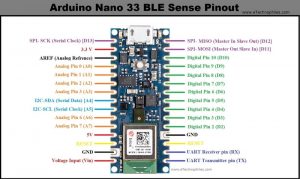Last updated on March 26th, 2024 at 04:10 pm
Arduino Nano 33 BLE sense is a microcontroller of the new generation launched by the Arduino company in July 2019. The board comes with a very powerful processor nRF52840, a 32-bit ARM® Cortex™-M4 CPU running at 64 MHz.
The board also features a lot of sensors that were not present in the previous nano board like a 9-axis Inertial Measurement Unit (IMU), temperature, pressure, humidity, light, color, and even gesture sensors. A microphone is also available and can be managed through specialized libraries.
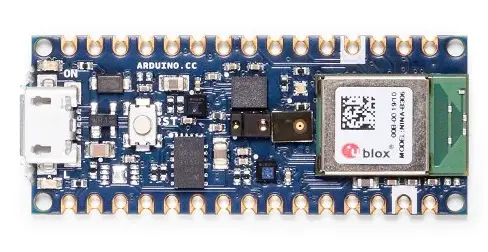
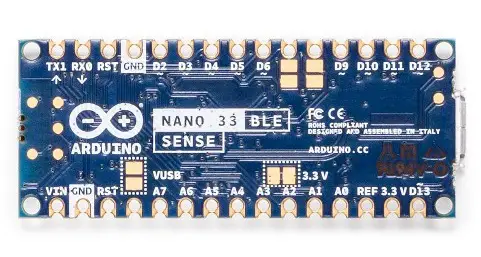
Note: This 33 BLE Sense Nano board works on 3.3V logic and shall not be considered as a direct replacement for the Arduino Nano. You can use this board as a normal Arduino board but the main purpose of using the new Nano boards is Wi-Fi and Bluetooth connectivity as well as running Machine learning algorithms in your project.
Table of Contents
Introduction to Arduino Nano 33 BLE sense

Note: BLE stands for Bluetooth Low Energy which is a low-power wireless communication technology that can be used over a short distance to enable smart devices to communicate. Its main focus is transmitting/receiving data wirelessly while consuming low energy. And 33 in Arduino Nano 33 BLE sense signifies that the board is compatible with 3.3V IP/OP. Whereas Sense means that there are inbuilt sensors on the board.
Processor: It comes with the nRF52840 chip, which is a 32-bit ARM Cortex-M4 CPU clocked at 64MHZ.
**Download the nRF52840 datasheet from here.
RAM and Flash Memory: It comes with 256KB of RAM and 1MB of CPU flash memory.
USB micro power port: The board comes with a micro USB port that connects it to a PC and also powers the board.
The embedded sensors in Arduino Nano 33 BLE sense
LSM9DS1-9 axis IMU: The chip features a 3D digital linear acceleration sensor, a 3D digital angular rate sensor, and a 3D digital magnetic sensor. And is used to measure the linear acceleration, angular velocity, and magnetic field strength respectively on all three axes. The max refresh rate for the accelerometer and gyro is 952Hz and up to 80 Hz for the magnetometer.
HTS221: HTS221 Capacitive Digital Humidity & Temperature Sensor is an ultra-compact sensor for relative humidity and temperature. It comes with a sensing element and a mixed-signal ASIC (Application-Specific Integrated Circuit) to provide the external environment information through digital serial interfaces.
APDS9960: The chip features advanced gesture detection, proximity detection, digital ambient Light Sense (ALS), and Color Sense (RGBC). The chip includes an IR LED and factory-calibrated LED driver for drop-in compatibility with existing footprints. Gesture detection uses a set of four directional photodiodes to sense reflected IR energy to convert the physical motion information (i.e. velocity, direction, and distance) to digital information.
LPS22HB: The LPS22HB is an ultra-compact piezoresistive absolute pressure sensor that functions as a digital output barometer. The chip comes with a sensing element and an IC interface which communicates through I2C or SPI interface to the Nano board.
MP34DT05-A: The MP34DT05-A is an ultra-compact, low-power, omnidirectional, digital MEMS microphone built with a capacitive element and an IC interface. The microphone is capable of detecting acoustic waves, it is manufactured using a specialized silicon micromachining process dedicated to producing audio sensors.
Pinout
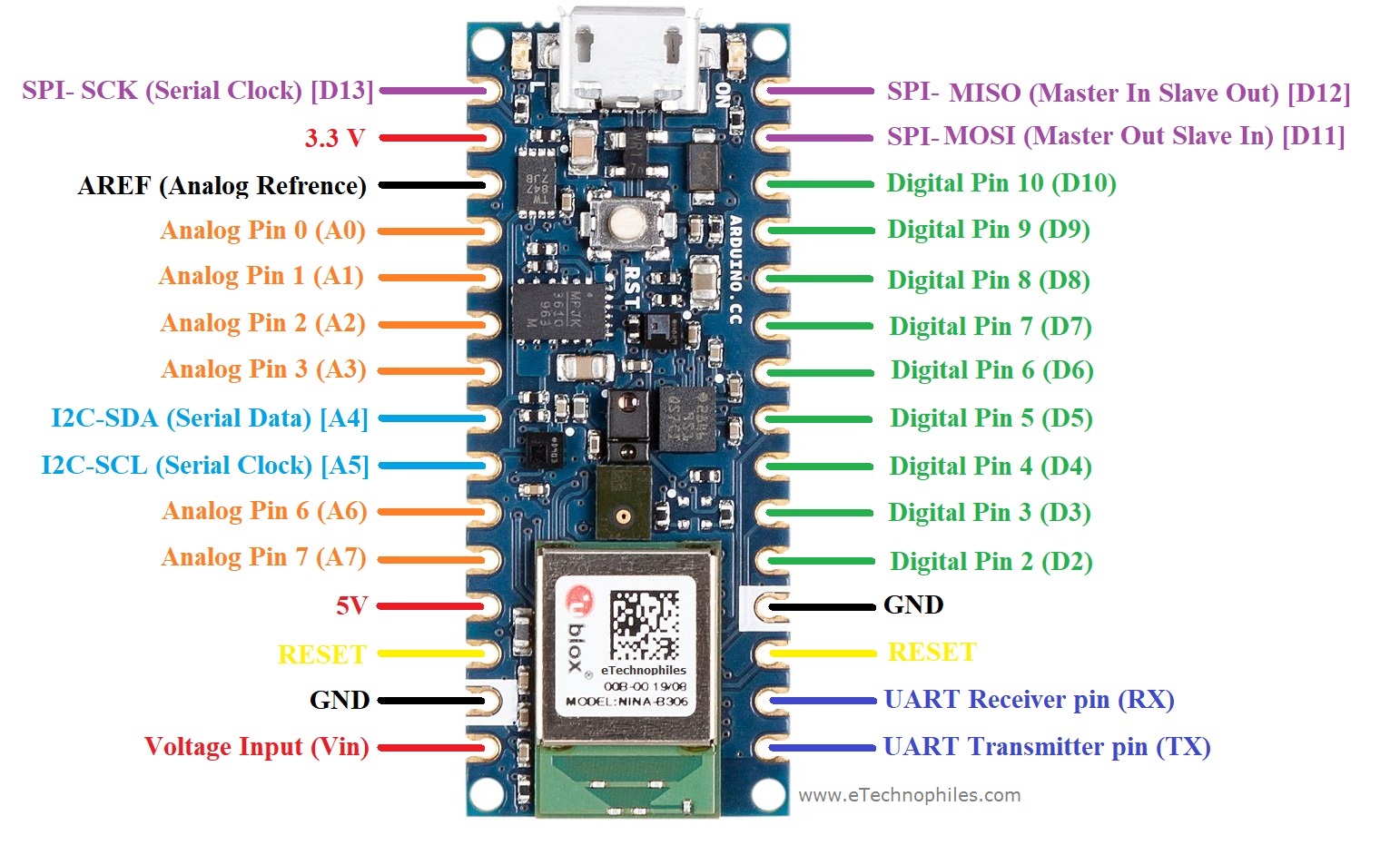
Vin
It is the modulated DC supply voltage, which is used to regulate the IC’s used in the connection. It is also called the primary voltage for IC’s present on the Arduino board.
Digital pins
There are 14 digital I/O pins. The Arduino digital pins can read only two states: when there is a voltage signal and when there is no signal. This kind of input is usually called digital (or binary) and these states are referred to as HIGH and LOW or 1 and 0.
PWM pins
All the digital pins on Arduino Nano 33 BLE sense are PWM (Pulse Width Modulation) enabled pins which are numbered from D0 to D13. Every one of these digital pins can generate a Pulse Width Modulation signal of 23-bit resolution. We can generate the PWM signal using the analogWrite() function in the program.
Analog pins
The board consists of 8 analog input pins numbered from A0 to A7 while the analog output can only be achieved using PWM pins. This means we can connect up to 8 analog input sensors to the board. The function of Analog pins is to read the value of the analog sensor used in the connection. Each of these analog pins has an inbuilt ADC of resolution of 212 bits.
I2C pins
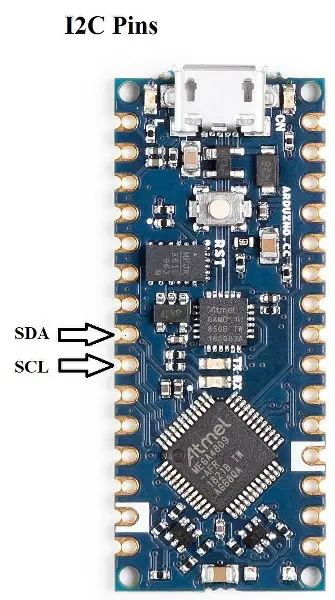
It is the two-wire serial communication protocol. It stands for Inter-Integrated Circuits. The I2C interface uses two pins for communication, to send and receive data: a serial clock pin (SCL) and a serial data (SDA) pin.
- SCL-It stands for Serial Clock. It is defined as the line that transfers the clock data. It is used to synchronize the shift of data between the two devices. The Serial Clock is generated by the master device.
- SDA-It stands for Serial Data. It is defined as the line used by the slave and master to send and receive data. That’s why it is called a data line, while SCL is called a clock line.
I2C Pins on the board: A4(SDA), A5(SCL)
SPI pins
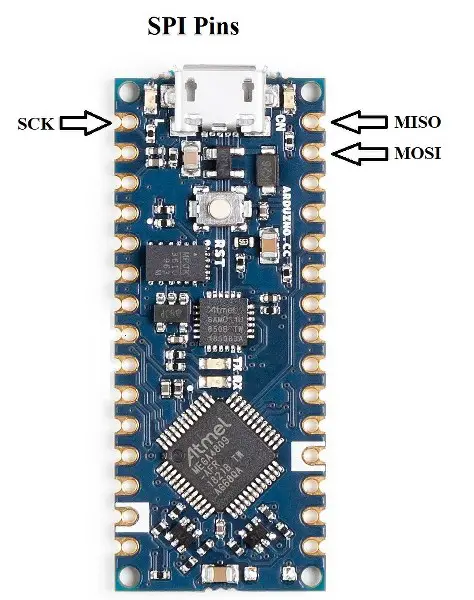
It stands for Serial Peripheral Interface. It is used by the microcontrollers to communicate with one or more peripheral devices quickly. There are three common pins to all the peripheral devices.
- SCK-It stands for Serial Clock. This pin generates clock pulses, that is used to synchronize the transfer of data.
- MISO-It stands for Master Input/ Slave Output. This data line in the MISO pin is used to send the data to the master.
- MOSI-It stands for Master Output/ Slave Input. This line is used for sending data to the slaves/peripheral devices.
SPI pins on the board: D13(SCK), D12(MISO), D11(MOSI)
RXD and TXD
TXD and RXD pins are used for serial communication. The TXD is used for transmitting the data, and RXD is used for receiving the data during serial communication. It also represents the successful flow of data from the computer to the board.
UART pins: D0(TX), D1(RX)
Other pins
3.3V: The 3.3V pin works as the output-regulated voltage of 3.3V.
Note: Arduino Nano 33 BLE Sense only supports 3.3V logic. So applying 5V logic can damage the board.
5V: The 5V pin outputs 5v to the external components. The power source of 5V for the Arduino Nano board is through the USB connector and the Vin pin.
Note: One more thing to keep in mind is that the 5V pin is disabled by default so you need to bridge the solder jumper at the bottom of the board to enable this pin.
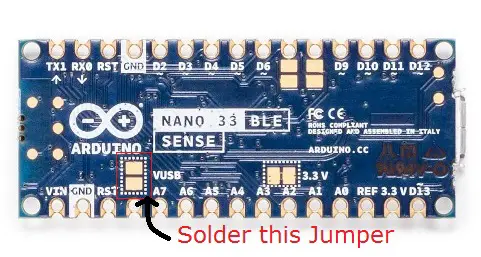
Once enabled, the 5V will directly pass through the USB cable to this pin because there is no onboard 5V regulator.
GND (Ground pins): There is a total of 5 ground pins on the board.
RST: It is used to add a Reset button to the connection.
AREF: This pin stands for analog reference. It provides the voltage reference at which the microcontroller is currently operating. Sending a signal to this pin does nothing.
LED indicators
Arduino Nano 33 BLE Sense board consists of 4 LED indicators:
Power LED(Green): It indicates that the Arduino board is powered ON.
Programmable LED (Orange): The board also comes with a built-in LED like every other Arduino board that can be programmed accordingly.
Programmable RGB LED: The board comes with a programmable LED that is connected to pin 22(RED), 23(Green), and 23(Blue)
Specifications
Given below are the technical specifications of an Arduino Nano 33 BLE sense.
| Microcontroller | nRF52840 |
| Operating Voltage | 3.3V |
| Input Voltage (limit) | 21V |
| DC Current per I/O Pin | 15 mA |
| Clock Speed | 64MHz |
| CPU Flash Memory | 1MB (nRF52840) |
| SRAM | 256KB (nRF52840) |
| EEPROM | none |
| Digital Input / Output Pins | 14 |
| PWM Pins | all digital pins |
| UART | YES |
| SPI | YES |
| I2C | YES |
| Analog Input Pins | 8 |
| Analog Output Pins | Only through PWM (no DAC) |
| External Interrupts | all digital pins |
| LED_BUILTIN | 13 |
| USB | Native in the nRF52840 Processor |
| IMU | LSM9DS1 |
| Microphone | MP34DT05 |
| Gesture, light, proximity | APDS9960 |
| Barometric pressure | LPS22HB |
| Temperature, humidity | HTS221 |
| Length | 45 mm |
| Width | 18 mm |
| Weight | 5 gr (with headers) |
Schematic (official)
**To download the schematic in PDF format, click here.

FAQs
What sensors are on the Arduino Nano BLE 33?
The Arduino Nano 33 BLE Sense features a 9-axis IMU (accelerometer, gyroscope, magnetometer), temperature, humidity, barometric pressure, microphone, gesture, light, and color sensors.
Does Arduino Nano 33 BLE have Bluetooth?
Yes, the Arduino Nano 33 BLE does have Bluetooth capabilities
What is the minimum voltage for Nano 33 BLE?
The Arduino Nano 33 BLE operates with a minimum voltage of 3.3 volts (V).
What is the use of Arduino Nano 33 BLE Sense?
The Arduino Nano 33 BLE Sense is used for IoT and sensing projects, featuring integrated sensors for motion, environmental monitoring, sound detection, gesture recognition, and more.
